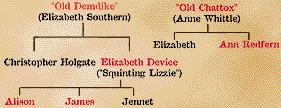The Pendle Witches lived during the reigns of Elizabeth I (1558 – 1603) and James I (1603 – 1625). As a result of King James I’s firm belief in the existence of witchcraft, an Act was passed which imposed the death penalty “for making a covenant with an evil spirit, using a corpse for magic, hurting life or limb, procuring love, or injuring cattle by means of charms”.
Two families were at the centre of the Pendle case. Significantly, both were headed by elderly widows who were known locally by their nicknames:

The names in red print signify those defendants from Pendle who were accused of witchcraft, five of whom were tried at Lancaster Castle – “Old Demdike”, aged 80, had died in prison at Lancaster Castle whilst awaiting trial.
Also accused were:
- Jane Bulcock and her son John Bulcock
- Alice Nutter
- Katherine Hewitt (“Mouldheels”)
The trial took place in August 1612, with Judge Bromley presiding, accompanied by Judge Altham. The Judges were assisted by Lord Gerard and Sir Richard Hoghton. The Prosecutor was a former High Sheriff of Lancashire, Roger Nowell of Read Hall, near Burnley, who had sent the accused for trial, and the Clerk of the Court was Thomas Potts of London.
The prisoners were not allowed to have defence counsel to plead for them, nor could they call any witnesses to speak on their behalf.
In addition to the ten defendants from the Pendle locality, the so-called Samlesbury Witches – John Ramsden, Elizabeth Astley, Isabel Southgraves, Lawrence Haye, Jane Southworth, Jennet Brierly and Ellen Brierly – along with Isobel Robey from Windle, near St Helens and Margaret Pearson, the Padiham Witch, were also tried. Much of the evidence given by prosecution witnesses was inconsistent, based on rumours, idle gossip and false confessions. The chief prosecution witness against the Pendle Witches was Jennet Device, granddaughter of “Old Demdike”.
At the end of the three-day Assize, a total of 10 people were found guilty of witchcraft, sentenced to death and hanged on the moor above the town. They were:
- Anne Whittle (“Old Chattox”)
- Ann Redfearn
- Elizabeth Device (“Squinting Lizzie”)
- Alice Nutter
- Alison Device
- James Device
- Katherine Hewitt
- Jane Bulcock
- John Bulcock
- Isobel Robey
Margaret Pearson was also found guilty, but not executed. Instead, she was sentenced to be pilloried on four consecutive market days in Padiham, Clitheroe, Whalley and Lancaster, and then to serve one year in prison. All of the Samlesbury Witches were acquitted, as was Alice Grey.
Another name, that of Jennet Preston, is often linked with this trial, but she had been hanged in York in July 1612 on the orders of the same Judges who sat in Lancaster a month later.








